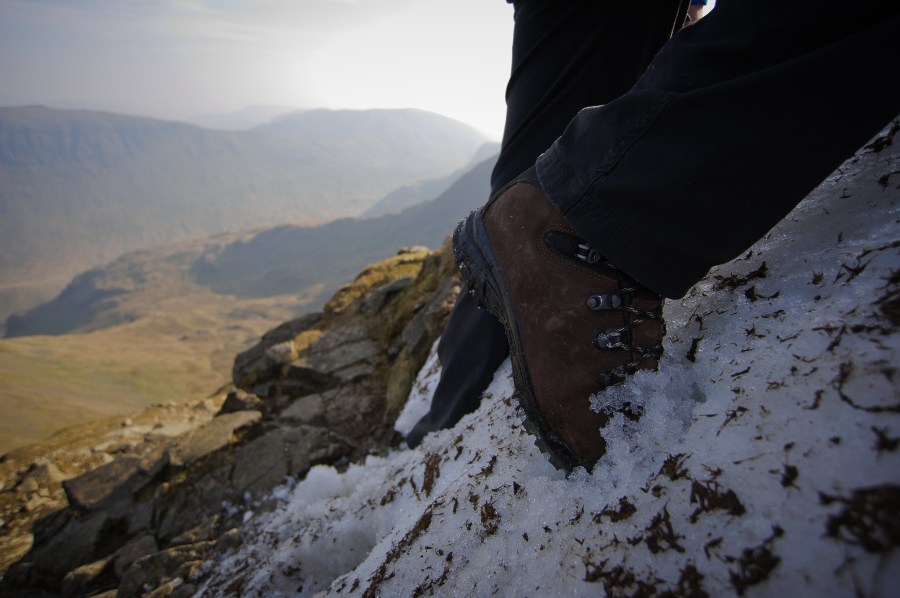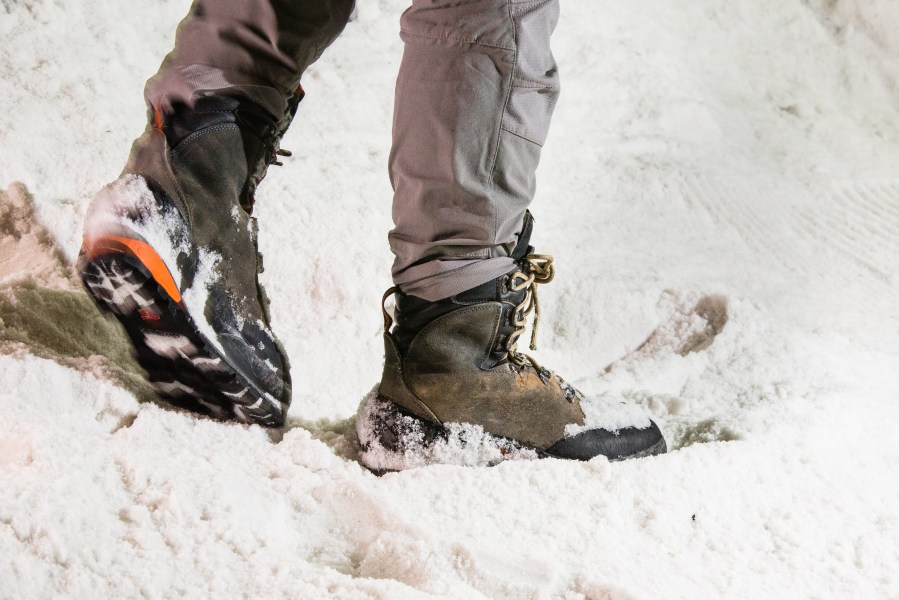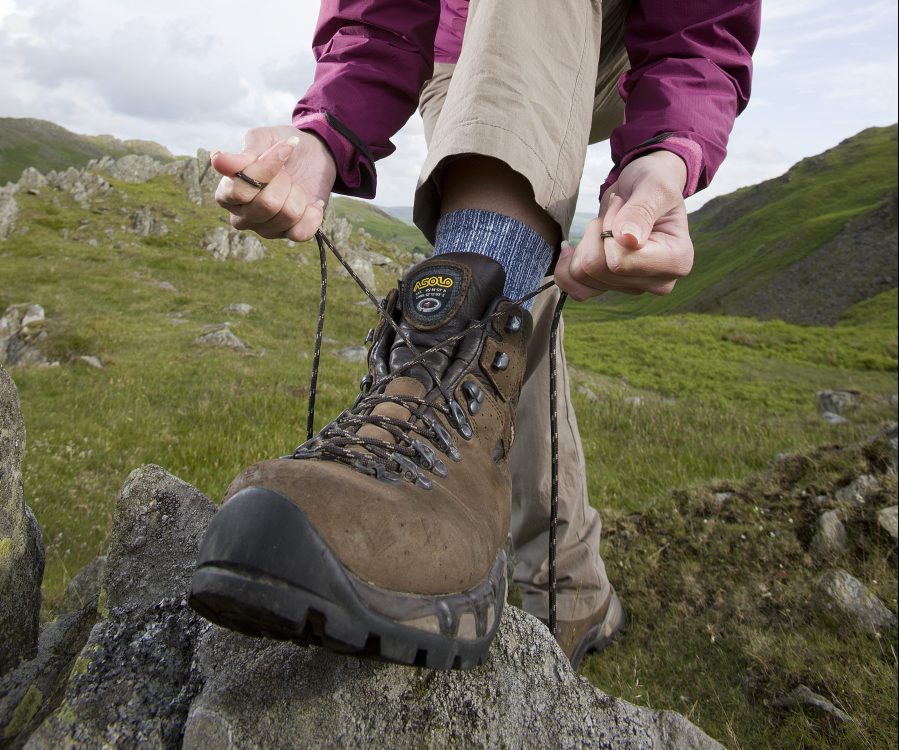These boots were made for walking but soles can get walked through. So, here’s a guide to resoling or repairing your walking boots.
It’s a familiar tale. Your best hiking boots have started to show signs of wear but you’re not ready to say goodbye. They’ve been with you through thick bog and thin cloud; climbed the highest mountain and scrambled down gorges. The fit is perfect. The specs suit your adventures. So, can walking boots be resoled or repaired? You might be in luck. Perhaps you needn’t ditch your old faithful pair just yet because, in some cases, hiking boots can be repaired.
In fact, we strongly recommend repairing your tired outdoor gear rather than simply replacing it with a shiny new kit at a great cost to you and the environment. However, the question many walkers are left wondering is not only can walking boots be resoled or repaired, but whether it is financially worth doing when it might cost less to get a new pair. We will address these concerns in this guide, along with advice on how, where, and when to repair or replace.
- What types of hiking boots can be resoled?
- When should you think about repairing your walking boots?
- How much do repairs cost?
- Can I resole or repair my own walking boots?
- How much harm will new boots really cause to the environment?
Words: Francesca Donovan | Main image credit: Tony West
Can walking boots be resoled or repaired?
What types of hiking boots can be resoled?
There are, unfortunately, some hiking boots that have been constructed in a way that means they can’t be resoled very easily. These are generally boots made by sewing or gluing the insole onto the upper, creating one solid unit with the sole. Should your sole then get worn, some repairers can sand it down to glue on another. But this doesn’t technically constitute a full sole replacement and wouldn’t solve any issues with the boot inner, necessarily.

Credit: James Roddie
Other hiking boots are designed with a strong upper that can outlast a few resoles. With that in mind, resoling has been made easier with a double-stitched construction attaching the sole to the upper but making it easier to separate old soles. Brands known for this approach include Danner, Hanwag, Lowa, Meindl, and Scarpa.
When should you think about repairing your walking boots?
While boot maintenance – cleaning and waterproofing – and correct footwear fitting can keep your boots in good nick for longer, it is inevitable that a well-worn pair of boots that has done the mileage will need some repair work.
Despite technological advances in materials, sole damage is the main concern with your old stompers. Most of us have an uneven gait resulting in hotspots on the soles of our boots that can wear down. Keep an eye out for cracking and if you notice a significant reduction in depth on the treads or lugs, take them for repair before it wears down to the midsole. It is much easier to repair a hardy sole than the softer midsole.
The midsole is also likely to need some attention after many miles. The heel area and the toe areas are both prone to rubbing, wear and tears in the lining. Colour fade and thinning material are both signs that your boots’ midsole needs some preventative repair work. But be aware that any major repairs to these areas may well change the fit of the boot. It may be best to replace the shoes at this stage.

Hiking boots on Helvellyn. Credit: Dave Willis.
The uppers are also vulnerable to elemental wear. Anyone who has trudged through bog will know how the hills can do a number on even the toughest hiking boots. Heat damage can ruin waterproofing and crack materials. You can recognise heat damage as the upper will look faded and stained even after it’s dry. Put preventative measures in place by stuffing your boots and allowing them to dry. Clean and polish them, too, as repairing the uppers beyond a quick stitch fix or a patch-up can be difficult.
These main factors aside, also keep an eye out for issues with laces, eyelets, stitching and the overall shape of the boot. Use your best judgment as to whether your pair is safe and comfortable for walks.
How much do repairs cost?
First, it’s worth checking your boot warranty with the manufacturer. If the boots are within warranty at the time of needing repair, some brands will offer repairs, replacements or discounts. They can also direct you to reputable boot repair companies that know the brand.
The good news is that most repairs are cheaper than purchasing a brand-new, high-quality pair of walking boots. It just depends on the repair you need. Eyelets are generally the cheapest repair available (around £10), with stitching becoming a little more expensive (around £30).
Sole replacements get more expensive, still, generally starting at the £60 mark. For example, a Vibram sole replacement is priced at £60 whereas a half sole and heel is £45 at the Boot Repair Company. These prices are reflective of the resoling market, with other companies such as Lancashire Sports Repairs offering brand-specific resoling for £85.

Credit: Dougie Cunningham
Some companies offer bespoke pricing depending on the necessary repairs. It’s worth seeking out a company local to you as the postage can get pricey. Most importantly, make sure you look for an experienced craftsperson who won’t damage other areas of the boot during repairs. Again, contact your boot manufacturer for specific advice first.
Can I resole or repair my own walking boots?
Shoe repairs are a fiddly business. Anything above and beyond a simple sole replacement becomes incredibly tricky, unless you are a trained cobbler. Likewise, you’d need specialist equipment and a lot of time to get even a resoling right. Given how important the comfort, fit and durability of your hiking boots are when you’re in the hills, we wouldn’t recommend you DIY your way out of worn-out footwear for walking.
How much harm will new boots really cause to the environment?
A study commissioned by Climate Works in 2017 found that the footwear industry is responsible for 1.4% of global greenhouse gas emissions. While some outdoor brands are making moves to manufacturing more sustainably, hiking boots are still often made using leather goods, which can be problematic.
There are, of course, occasions when your boots have to be replaced. Ill-fitting boots without the appropriate level of comfort and protection for your feet can cause injuries and accidents. There are also constantly developing technologies in footwear that many will want to take advantage of to make adventures more comfortable.
To counterbalance these impacts, many outdoor brands are moving towards a more sustainable manufacturing model. Some including Hanwag, Scarpa, Mammut, Lowa, Meindl, Danner, Salewa and La Sportiva, offer repair services. Quoting the statistic that 22 billion pairs of shoes are dumped into landfill each year, Vivobarefoot launched their ReVivo campaign, an end-of-life reconditioning service for boots. So, there are paths you can take when replacing your hiking boots that will help you leave a lighter tread on our planet. Just ask yourself: Can walking boots be resoled or repaired?
One last top tip is to be wary of green-washing marketing tactics and do the research within your budget. You can take a look at our guide to the best hiking boots which covers boots for women, men and children if you decide it’s time to move on with a new pair.








